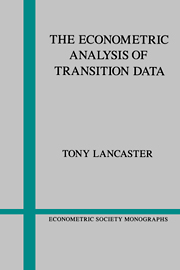Book contents
- Frontmatter
- Part I Model Building
- 1 Some Basic Results
- 2 Covariates and the Hazard Function
- 3 Parametric Families of Duration Distributions
- 4 Mixture Models
- 5 Some Important Processes
- 6 Some Structural Transition Models
- Part II Inference
- Appendix 1 The Gamma Function and Distribution
- Appendix 2 Some Properties of the Laplace Transform
- Bibliography
- Index
1 - Some Basic Results
Published online by Cambridge University Press: 05 January 2013
- Frontmatter
- Part I Model Building
- 1 Some Basic Results
- 2 Covariates and the Hazard Function
- 3 Parametric Families of Duration Distributions
- 4 Mixture Models
- 5 Some Important Processes
- 6 Some Structural Transition Models
- Part II Inference
- Appendix 1 The Gamma Function and Distribution
- Appendix 2 Some Properties of the Laplace Transform
- Bibliography
- Index
Summary
Introduction
An Overview of the Book
This book is about the movement of individuals among a set of states, and a transition is a movement from one state to another. Transition data record the sequence of states that were occupied and the times at which movements between them occurred. The states will be finite in number and may be defined in any way that the economics of the problem suggests is useful. All that is required is that they be clearly defined and that we have a rule for telling which state a person is in at each moment of time. Some simple examples of states might be
Unemployed,
Employed,
Out of the labour force;
or
Married,
Unmarried;
or
Employed,
Retired.
Our concern will be with the passage of people among such sets of states. We shall give an account of the building of models for such movement, of the fitting of such models to data, and of the use of models and data to test economic and statistical hypotheses. In the first part of the book - chapters 1 through 6 - we shall describe ways of building models for fitting to transition data. In the rest of this introductory chapter we shall give an account of the two fundamental tools for the study of duration data, the hazard function and the Exponential distribution, and we shall examine some duration data.
- Type
- Chapter
- Information
- The Econometric Analysis of Transition Data , pp. 3 - 20Publisher: Cambridge University PressPrint publication year: 1990



